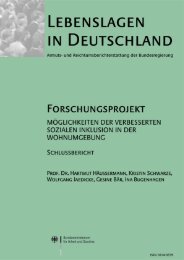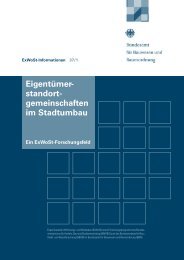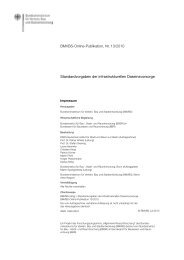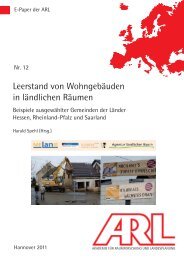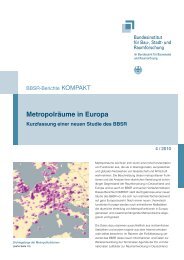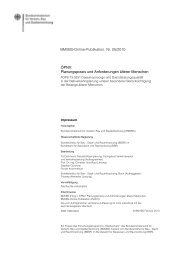Download - Fachgebietes Ãkonomie des Planens und Bauens ...
Download - Fachgebietes Ãkonomie des Planens und Bauens ...
Download - Fachgebietes Ãkonomie des Planens und Bauens ...
Sie wollen auch ein ePaper? Erhöhen Sie die Reichweite Ihrer Titel.
YUMPU macht aus Druck-PDFs automatisch weboptimierte ePaper, die Google liebt.
Summary<br />
11<br />
Summary<br />
Urban Development Grants as a part of the system of<br />
urban regeneration in Germany have been a flexible<br />
instrument for several deca<strong>des</strong> that was able to create<br />
multiple leverage effects and to stimulate private<br />
investment. The measures and f<strong>und</strong>ing in the program<br />
of “Städtebauliche Sanierungsmaßnahmen” building<br />
on area-based regeneration has been completed in<br />
numerous areas, and one may ask if the f<strong>und</strong>ing areas<br />
were able to return to “normality”. The Federal Institute<br />
for Research on Building, Urban Affairs and Spatial<br />
Development therefore launched a case study based research<br />
project that was supposed to analyze long-term<br />
effects and to give recommendations for a possible<br />
increase in effectiveness of the program.<br />
The methodology of the study had to face the enormous<br />
range of different types of regeneration strategies that<br />
reflects the great flexibility of the program. It had to<br />
include a number of areas in which the regeneration<br />
process has not yet been completed to be able to cover<br />
East Germany where the program was invented only<br />
after 1990. As a result, the study confirmed earlier<br />
studies that stressed the high flexibility and appropriateness<br />
of the program to upgrade neighbourhoods<br />
with multiple development constraints and symptoms<br />
of urban blight. The main types of neighbourhoods that<br />
are covered by the program are historic cores of small<br />
and middle-sized towns on the one hand and compact<br />
inner city neighbourhoods from the late 19th and early<br />
20th centuries. Besi<strong>des</strong>, the program covers various<br />
other types of neighbourhoods such as reconstructed<br />
inner cities, the regeneration of abandoned industrial<br />
or military sites and workers’ villages to name but a<br />
few. The main goal of the local strategies is a careful<br />
regeneration that tries to keep and to modernize as<br />
much of the old housing and building stock as possible.<br />
The regeneration process is to contribute to liveability,<br />
social cohesion and economic attractiveness of the<br />
neighbourhoods. Main approaches are the improvement<br />
of public spaces and social infrastructure and the<br />
preservation of monuments.<br />
Urban regeneration poses a high bureaucratic challenge.<br />
The complexity, the high number of stakeholders<br />
and the long-term orientation of regeneration procedures<br />
require the establishment of powerful organizational<br />
structure within and transcending the city hall.<br />
An analysis of the procedures shows that the interdepartmental<br />
cooperation is usually well organized.<br />
Many cities make use of trustees or agents that are able<br />
to cope with the complex procedural needs. However,<br />
many smaller towns try to control the implementation<br />
themselves and to avoid the costs of agents. In bigger<br />
cities the procedures are very complex, and the cities<br />
need to care for making regeneration a high priority<br />
policy issue and to integrate the departments constructively<br />
so as to be able to complete the regeneration<br />
process speedily. After sometimes very conflictive<br />
first years, the cities mostly managed to establish civic<br />
regeneration councils and to get civil society initiatives<br />
involved and thus substantially improved their communication<br />
and participatory tools. However, in some<br />
cities the standard of participation is still mo<strong>des</strong>t.<br />
There are two groups of cities when it comes to analyzing<br />
the regeneration strategies, one focussing mostly on<br />
infrastructural measures and the other on construction<br />
measures. The first group consists mainly of small and<br />
medium-sized towns that try to functionally upgrade<br />
their cores. The second group is dominated by bigger<br />
cities where upgrading the housing stock is particularly<br />
important. Both strategies can be successful if they<br />
care for a consistent allocation of resources throughout<br />
the regeneration process and if they avoid lopsided<br />
concentrations. Infrastructural measures contribute to<br />
a stimulation of private investment especially in small<br />
and medium-sized towns. In bigger cities this strategy<br />
is applied nowadays, too, but historically trustees or<br />
public housing companies were stronger in developing<br />
the housing stock themselves. While poorer municipalities<br />
have problems bringing up their co-f<strong>und</strong>ing,<br />
many cities and towns are able to actively b<strong>und</strong>le additional<br />
f<strong>und</strong>ing from other programs, especially when<br />
they integrate their regeneration strategy into the<br />
Langzeitwirkungen <strong>und</strong> Effektivierung der Städtebauförderung



